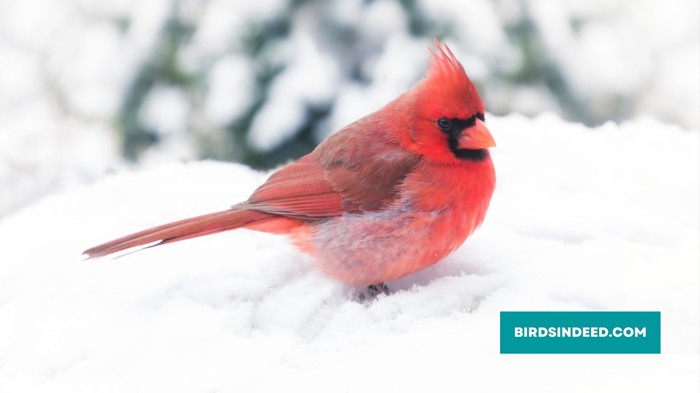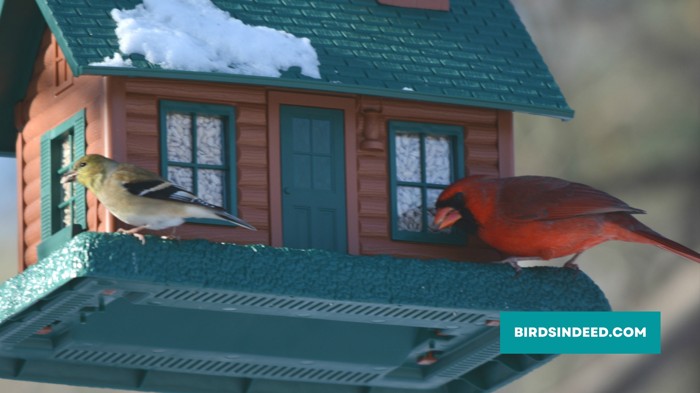Cardinals are very popular songbirds known for their bright red plumage. They are commonly found in wooded areas and suburban gardens in North America. Many people are familiar with Northern Cardinals as they are often seen during the winter months while other birds have migrated south. However, cardinals are not known to be migratory birds, they are found in their home range throughout the year.
So, the question is, do cardinals migrate? No, they don’t. Northern Cardinals are non-migratory birds which means they stay in the same place all year round. They are found in the eastern, southeastern, and mid-western parts of the United States, southern Canada, and parts of Mexico. They can survive in harsh winter conditions by fluffing up their feathers to trap a layer of warm air next to their body and also by eating high-energy foods like sunflower seeds, berries, and suet.
Now, let’s take a look at the in-depth explanation of “Why Northern Cardinals do not migrate?”, We will also talk about some other facts about the cardinals’ adaptation to the cold winter!

Contents
Why Don’t Cardinals Migrate?
The Northern Cardinal is an amazing species, surviving and thriving in territories that are new and colder than ever before. Their adaptation is truly remarkable. It is incredible how they have evolved over the past century to not only survive but also to expand and adapt in such regions. However, the diet of a bird determines whether it will migrate in the winter. The main reason why cardinals do not migrate is food accessibility. Besides food, there are a few reasons why they do not need to migrate in the winter. We’ll look into these reasons in the following manner:
- Adequate food supply: Cardinals can find enough food to survive the winter, such as seeds, berries, fruits, insects, grains, and suet. While many bird species need to migrate during the winter months because of food scarcity, cardinals can still forage for specific insects and seeds. Although incest is infrequent in the winter, cardinals still rely heavily on vegetables for their diet from November to February. This dependence is greater than 70% on seeds, grains, and other vegetables.
- Adaptability to harsh weather: They have a thick plumage that provides insulation against cold temperatures and they can fluff up their feathers to trap a layer of warm air next to their body, which helps them to survive in cold weather.
- Controlling blood flow: Northern cardinals possess remarkable mechanisms to control their body temperature, eliminating the need for migration. They actively regulate their internal heat by adjusting their behavior and physical attributes. They engage in short-distance flights to locate food sources, which keeps their bodies active and generates warmth. Moreover, cardinals adapt by changing the direction of blood flow and promoting circulation through the fluffing of their feathers. Incredibly, there are indications that cardinals intentionally shiver, which increases blood flow and helps to maintain their body temperature. These adaptive strategies enable northern cardinals to thrive in various habitats, even during colder seasons.

- Range of habitat: Northern Cardinals have a wide range of habitats and are found in the eastern, southeastern, and mid-western parts of the United States, southern Canada, and parts of Mexico. They are able to survive in a variety of environments and climates.
- Breeding habits: They breed throughout the year and are not dependent on seasonal changes. They don’t need to rely on the weather for mating or breeding.
- Low predation pressure: In the winter, Northern Cardinals have relatively low predation pressure, meaning that they are not at high risk of being hunted or killed by predators.
All these factors combined make it unnecessary for Northern Cardinals to migrate. They can survive and thrive in the same location all year round.
Where Do Cardinals Go For The Winter?
Year-round Residents and Seasonal Movements: Cardinals are year-round residents in many parts of North America, so they do not typically migrate to warmer climates for the winter. They can be found in the southeastern United States, as well as in the central and eastern parts of the continent. However, some populations of cardinals may move southward during the winter months to areas with milder temperatures and more food sources. These movements are typically not long distances and are considered more as irruptions.
Range, Territory, and Site Fidelity: Northern Cardinal is a widespread species, found across a vast range spanning from the eastern coast to the central plains of the United States. It also extends into certain areas of the desert southwest and Mexico. Each cardinal establishes its own territory, which typically encompasses an area ranging from 2 to 10 acres. A study has found that cardinals stay at their specific territory on average for 77% of their lives. Interestingly, these beautiful birds exhibit strong site fidelity, as they tend to remain within approximately a mile of their established home range throughout the year. This behavior ensures their familiarity with local food sources, nesting sites, and other essential resources.

Adaptability in Human-Altered Landscapes: They are also a permanent resident in the southern parts of Canada and the United States. Some birds may move short distances in search of food, but most cardinals stay in their territory throughout the year. The Northern Cardinals are known to adapt to human-altered habitats such as backyard bird feeders, parks, and gardens which can offer food resources even in the winter and help them to survive. This adaptability not only supports their survival but also enhances our opportunities to observe and appreciate their vibrant presence in close proximity.
How Do Cardinals Adapt To The Winter?
One of the ways cardinals survive the winter is through their thick plumage. Cardinals have a dense layer of feathers that helps to insulate their bodies from the cold. They also have a specialized type of feather called a down feather, which is located under their outer feathers. This down feather helps to trap a layer of warm air next to the skin, providing additional insulation. Additionally, when the temperature drops, cardinals will fluff up their feathers to create an even thicker barrier against the cold.
Another way cardinals survive the winter is through their diet. Cardinals are able to find food during the winter by foraging for seeds and berries. They are also able to eat certain insects which are found in winter. Some cardinals also visit backyard bird feeders to supplement their diet. These birds are opportunistic feeders and will eat insects, fruits, and even other small animals, if available.

Cardinals are also able to lower their metabolism during the winter to conserve energy. This allows them to survive on less food and still maintain their body heat. They also have the ability to go into a semi-hibernation-like state, during which they will spend more time roosting and less time active. This helps them to conserve energy and survive the cold winter months.
In addition to these adaptations, cardinals also have a strong immune system that helps them to fight off any diseases that may occur during the winter. They also tend to form social bonds, which can also provide some protection in harsh weather.
And as we mentioned in the previous part, cardinals can change their blood flow, and they fly here and there to keep their bodies warm. These naturally smart birds also intentionally shiver to raise their body temperature.
Overall, cardinals are well-equipped to survive the winter and continue to thrive in many parts of North America. Their thick plumage, diet, and ability to lower their metabolism help to keep them warm and survive the cold winter months. They are also hardy species, which makes them well-suited for surviving in a variety of different climates and habitats.

That’s All, Folks!
In conclusion, cardinals do not migrate. They have the ability to control their body temperature and can endure long, bitter winters. Throughout the winter, Northern Cardinals seek for food and find shelter in their usual regions. They’ve mastered the art of finding wonderful food sources to scavenge and appropriate resting spots when it’s cold and snowy. They will wander and scavenge throughout the Central Plains, the Southern, and the Eastern United States. Instead of nesting in tree cavities or birdhouses, they seek shelter among dense trees, shrubs, and bushes. The ability to regulate body temperature helps cardinals to stay warm in the winter. They fluff and arrange their feathers to generate more body heat. Additionally, they wander across their territories to keep themselves warm when the weather is chilly. So, the next time you see a red cardinal in your backyard during the winter, you can take comfort in knowing that it is well-adapted to the cold and is likely to continue to thrive.
Kazi Rifat is the Editor & Author at Birds Indeed, a blog dedicated to all things avian. With a passion for birds and a background in Computer Science, Kazi brings a unique perspective to the world of bird watching and conservation. Follow along on his feathery adventures and learn something new every day.







